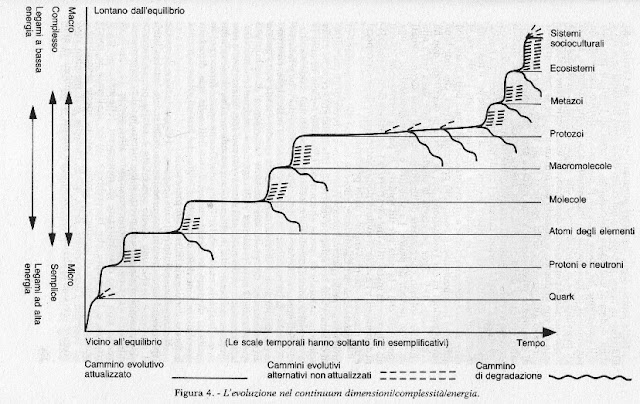The hierarchical level 5 of ecosystem - both local and global - represents the highest degree of complexity of a system.
The term is attributed to the ecologist and botanist A.G. Tansley in 1935 to define the whole of living and non-living elements which are linked together and in equilibrium by a variety of complex relations of interdependence.
and, in detail, for the physical hierarchy:
and for the ecological ones:
and for the ecological ones:
A hierarchical description may be applied to specific parts of the ecosystems, for example for geopolitical systems:
the term ecosystem intends to describe the complexity of the biosphere integrating living species and environment at all levels:
The hierarchical description of an ecosystem may naturally be extended at higher levels over the global planetary one and to lower under the physical ones:
 | |
| Hierarchical description levels from space-time continuum to metagalaxies. from: Ervin Laszlo, Introduction to Systems Philosophy, 1972 |
The global terrestrial ecosystem is in fact closed about biosphere but open for the physical level, where the main process is the radiation/reflection of the solar light.
The ecosystems represent the highest complexity level of systems with history and, as such, require for their comprehension the explicitation of their evolution in time or in other meaningful system variables; for example:
 |
| Global ecosystem evolution in terms of dimensions/complexity/bonding energy. from: Ervin Laszlo, Evolution of complexity and the contemporary world order. |
Similarly can be done by the sociocultural systems evolution:
 |
| Evolution steps of sociocultural systems. from: Ervin Laszlo, Evolution of complexity and the contemporary world order. |
The high complexity of the global ecosystem, which integrates and encloses that at all the lower levels, leads to some relevant characteristics:
system Globality and Locality: zoom levels
At the ecosystem level is natural to perform zoom levels from different points of view over the underlying subsystems, not necessarily only dimensional. At any zoom level an ecosystem is observed the resulting will be always another ecosystem, a consequence of the hologrammatic principle proposed by Morin where "not only the part is in everything, but everything is in the part. Each cell is a part of everything, but everything in itself is in the part. The entire gene is present in each individual cell. The society is present in every individual."
Mental processes of ecosystems
From the formulation of Bateson's criteria of mental processes it follows that if in a system just an element or process has mental characteristics there all the system is mental. Any ecosystem has therefore - in a global sense - the maximum characteristics of mental type processes.
Invariance and Scalability of systemic complexity
The hologrammatic and fractal characteristics of ecosystems reflect on the fact that scaling in any ecosystem into some system variable, dimensions typically, the system complexity is invariant and scales with scaling dimension. In this sense the complexity of a single cell amounts to that of the entire planetary ecosystem, naturally on different elements and processes.
For example, one may consider the complexity of the interaction between the sociocultural ecosystem and the global ecosystem:
 |
| Sociocultural systems in interaction with ecosystems. from: Ervin Laszlo, Evolution of complexity and the contemporary world order. |
in the sociocultural systems one may outline the economical system:
 |
| Schematics of the world economical system. |
to arrive to the single individual metabolism:
 |
| portion of the metabolic system |
 |
| Front and back views of a 3D model of the Golgi region in an insulin-secreting, mammalian cell. Three serial 400-nm-thick sections cut from a high pressure frozen, freeze-substituted and plastic-embedded HIT-T15 cell were reconstructed by dual axis EM tomography. Â The software package IMOD was used to model all visible objects within the resulting reconstructed volume (3.1 x 3.2 x 1.2 um3). The Golgi complex with seven cisternae (C1-C7) is at the center. Â The color coding is as follows: C1, light blue; C2, pink; C3, cherry red; C4, green; C5, dark blue; C6, gold; C7, bright red. The Golgi is displayed in the context of all surrounding organelles, vesicles, ribosomes, and microtubules: endoplasmic reticulum (ER), yellow; membrane-bound ribosomes, blue; free ribosomes, orange; microtubules, bright green; dense core vesicles, bright blue; clathrin-negative vesicles, white; clathrin-positive compartments and vesicles, bright red; clathrin-negative compartments and vesicles, purple; mitochondria, dark green. Bar, 500 nm. Image courtesy of Dr. Brad Marsh, Institute for Molecular Bioscience The University of Queensland, Brisbane, Australia. |
in all these systems of extremely different types the preserved and invariant characteristic is the system complexity, which scales with the system dimensions.
Weaving of the complexity
The complexity invariance with dimension is well sketched by the etymology of the term complex, which comes from complexus, or "with texture". The "texture" or "weaving" of complexity becomes palpable scaling on zoom physical levels down to the subatomic one:
 |
| portion of texture of an iranian carpet; scale about 50 cm. |
 |
| Optical microscope image by fluorescence and polarized light of carpet fibers; 20X zoom |
 |
| colored SEM image of silk fibers; 220X zoom |
 |
| I colored SEM image of silk fibers; 1300X zoom |
 | ||||||
| STM images of a single molecule before (left) and of a molecular chain (right) after the formation of intermolecular covalent bonds by “on-surface-synthesis”. The chemical structures of the initial building block and the chain are indicated. scale 2 nm Fritz-Haber-Institut der Max-Planck-Gesellschaft- Department of Physical Chemistry
|
































